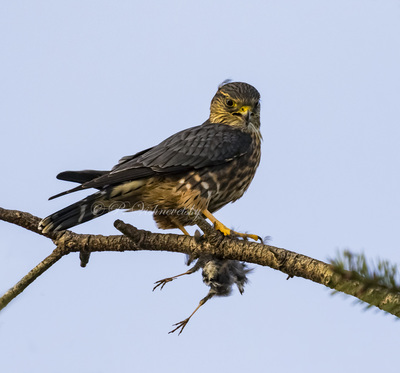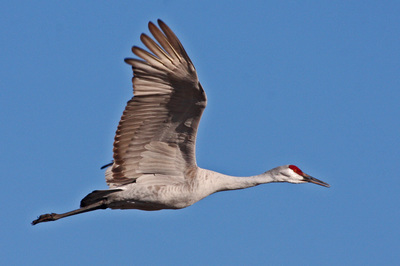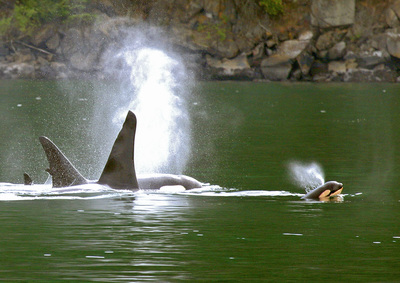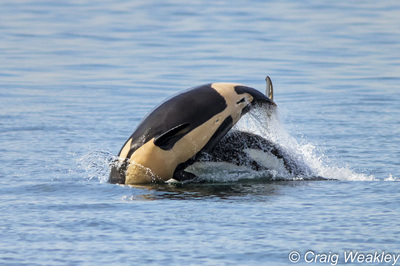 An Interview with Wildlife Photographer Patricia (Trish) Vishnevetsky 1. Why wildlife? (why do you shoot wildlife?) PV -Probably because growing up in New Zealand there wasn’t much “wildlife” to be seen however since coming to live in Washington State where you can see bald eagles, hawks, falcons, foxes, etc,, on a regular basis well that was a real eye opener for me. The beauty of these creatures is still amazing to me and I will never cease to be anything but in awe of them. 2. What was your first wildlife photograph? PV - A bald eagle. 3. Your favorite wildlife subject? PV - It would have to be all types of raptors. 4. Your favorite wildlife location? PV - That I can’t answer because everywhere you look there is something incredible just waiting to be photographed. 5. Most dangerous shot? PV - I can’t honestly say that I have been in any danger at any given time unless you call falling over into mud after waiting around in the freezing cold for some snowy owls to actually do something other than sleep. 6. Luckiest photograph you captured? PV - It was of a bald eagle taking off from a rock and the wing feathers covering its face in a striped pattern but leaving the eye shining thru. 7. Most memorable? PV - Kits, the innocence of them and the trust they sometimes show by walking up to you and just looking at you – quite takes your breath away. 8. Technique tip PV - Practice, practice and more practice and never be afraid to try something new. 9. Equipment tip PV - Make sure you have your camera with you at all times – you never know when “the” shot will happen. BIO
When I was living in New Zealand I had a Panasonic Lumix that I would take with me when going on hikes in the countryside. My photos mainly consisted of flowers and plants that were growing on the hillsides. However, since moving to the northwest and seeing a bald eagle for the first I just had to go out and photograph them which was no easy task after only stationary objects. Gradually with the assistance and splendid advice from some good folk I slowly learnt a bit more and with the help of my wonderful cameras (Canon 7D Mk II and Canon 5D Mk III) I am now able to get some reasonable photographs. Visit Trish's website
5 Comments
 An Interview with nature photographer Gwen Berthiez 1. Why wildlife? GB: I shoot wildlife because it takes me outdoors and brings peace & quiet to my soul, and wonderful, non-political, honest wildlife beauty to my senses – besides – it’s an excuse to be out in the woods and doing whatever I want to do – far away from offices & human nonsense stuff. 2. What was your first wildlife photograph? GB: An American Bald Eagle 3. Your favorite wildlife subject? GB: Raptors and whales of all kinds 4. Your favorite wildlife location? GB: Absolutely anywhere in the PNW 5. Most dangerous shot? GB: Cape Kiwanda while avoiding the sizable & unpredictable rogue waves 6. Luckiest photograph you captured? GB: A shot of a humpback whale in full breach lined up in front of Mt Baker & Mt Erie – awesome luck!!! It will never happen again for me. 7. Most memorable? GB: A beautiful little red fox, who thought I had something for him to eat, so he ran straight up to ‘speechless’ me. I had never seen a red fox before and was awed in the first place just to be near one, much less to be able to capture a very unsteady shot with a completely new & unfamiliar camera. 8. Technique tip GB: Especially with wildlife, if you are not out there – you cannot catch that image. Be there and take lots of photographs. When you go out, decide exactly what you are looking for & want to photograph. Take the right equipment all prepped to catch that shot. And even more important – know your equipment thoroughly. 9. Equipment tip GB: Keep it simple & don’t weigh yourself down with lots of unnecessary, heavy stuff – travel as lightly and as efficiently as possible. Bio:
I never hefted a camera before about five years ago and had no clue how to operate a ‘real’ camera – too complicated. And I was working too – no time. So when I retired, had discretionary time, and the awesome digital camera became available, I started taking pictures. The digital camera provided a wonderful creative outlet, which had had to be push to the background during the working stage of my life. So now I truly enjoy myself – no apologies. And I don’t have to dress up in the corporate uniform to do it. For me the Pacific Northwest offers a spectacular parade of entrancing images – a never-ending kaleidoscope of shapes, textures, and colors to entertain and delight the senses. I find Nature in all forms – landscapes, seascapes, wildlife, birds, – to be perfectly beautiful just as She is without any artificial enhancements Through my photography I attempt to capture and render Nature as simply and as accurately as possible. Gwen's website  An Interview with wildlife photographer Lynn Karns Why wildlife? (why do you shoot mostly wildlife?) Shooting photographs of wildlife gives me the opportunity to observe and capture moments when wild animals are just being themselves. They are constantly moving and changing and that is challenging to me. I love trying to find humorous photos, close up or beautifully lit photos. What was your first wildlife photograph? I have shot photographs of wildlife for as long as I can remember. The first time I realized that I really loved shooting wildlife was when I found myself lined up with birders and photographers in Florida on Sanibel Island waiting for a flock of Roseate Spoonbills to fly in at dusk. I thought about my father who was a wildlife biologist and an active participant in the Audubon Society. For the first time in my life I understood his passion for wildlife. Your favorite wildlife subject? Location? Probably my two favorite subjects are water birds and whales. The common denominator is the water. Since being around water is my favorite environment, I am attracted to photograph wildlife there. I have so much respect for whales and their close family ties that I want to try to tell that story so that others can see how important they are to protect and preserve. Water birds and raptors are graceful, wary, and proud. I want to show those qualities when I photograph. Most dangerous shot? I feel strongly that one needs to respect wildlife and not place yourself or the animal in danger. That said, however, there was one time when I was a little nervous. Dave and I were traveling in Canada close to the Canadian Rockies when we pulled into a rest stop. The tourists hadn’t come yet so we were the only ones there. As we started to exit the car I spotted three bears just about 10 feet from us and I jumped back into the car. We watched them wander around for a few minutes and then I carefully opened the door and took a few shots. Dave stuck his head out the sun roof. They looked up and gazed at us for a few minutes and then kept on looking for dandelions. I knew how fast a mother bear could move so I stayed behind the protection of the door but my heart was racing because they were so close. Fortunately we all were fine but unfortunately the bears were in fairly dark shade so we were not excited about our pictures later. Luckiest photograph you captured? I believe the luckiest photograph I ever captured was five years ago on my birthday. Dave and I went out to Washington Park loop road and were just getting out of our car to take pictures when a gal drove by yelling, “Come down to Green Point; the whales are coming.” We recognized the girl from going out with Island Adventures so we believed her and jumped back into our car. We drove down to where we believed she was talking about and then set up our tripods and cameras. In the distance we could see them coming. I kept watching through my lens and I saw a whale come up out of the water. I pressed down on my shutter release taking multiple pictures as the whale breached. Later we are able to stitch the pictures together and show a complete breach. We later identified the whale as Princess Angeline. I believe it was a very lucky shot. A friend of ours who has lived in Anacortes his entire life said, “I can’t believe it. I have never seen the orcas off Green point in my life.” I called it God’s birthday gift to me. Most memorable? Probably my most memorable moment also happened in Canada on a different trip to the Canadian Rockies and it also involved bears. We were traveling through Kootenay National Park when we saw some bears off the side of the road. There were cars beside them so we got in line behind them. When it was our turn to drive up close to them, I was surprised how close they were AND how active they were. I was “almost” afraid to put the window down. We also had to keep an eye out for the local state trouper because they were not happy with the tourists stopping. We got some fabulous pictures of them in the dandelions. I was on a high for weeks afterward. Technique tip Remember that wildlife is out at dawn and at dusk. Don’t waste your time looking during the heat of the day unless you are in a zoo. However, a zoo is a very good place to practice shooting photographs of wildlife. You really can capture some very nice shots since you have a captive audience. Equipment tip I have a 100 to 400 lens, 4.5-5.6 lens which I call my wildlife lens. It is portable and easy to handle. I don’t need to worry about depth of field when I am shooting far away so the speed of the lens is good for me. Shooting digitally with a small sensor, a 400 lens is equivalent to a 600 so the length is good also. I am not tied to a tripod because I can handhold this lens also. I believe every wildlife photographer should have a good long lens but it should be easy to handle.  Lynn Karns Bio I consider myself both a communicator and an artist. For most of my working life I was a English, journalism, and photography teacher in high school for 20 years and then at Grand Canyon University in Phoenix, Arizona for 10 years. My passion has been photography since I taught in Japan at a military base for two years, in 1969-71, bought a manual camera and spent as much time as possible traveling around the east attempting to photograph and tell a story at the same time. When I came back to the U.S., I took 18 hours of photography from Arizona State University and began incorporating photography into my teaching. I loved watching students “catch the bug” like I had. I retired in 2005 and moved with my husband to the Northwest where I love to travel and photograph the beautiful vistas and wildlife available to us. Website  An Interview with wildlife photographer, Sammy Catiss by Karla Locke Why wildlife? It’s the one thing that connects me. Growing up in the foothills of Mt. Rainier, I have met most every critter we have at one point or another. Learned when to hold still and when to back away. I’ve never been afraid of anything wild but have always respected it. My first Wildlife photos would have had to have been the deer, rabbits and squirrels that frequented my property, which was sat way out on the edge of the foothills. I remember, and still have the shots I believe, of a Flying Squirrel that would climb into a box I had put up for him with a clear front to watch him eat. He would climb in and shut the top hatch so he could eat while being dry. He could care less if I got up close to him with the camera. And the wild Turkey that was infatuated with my chickens. My favorite wildlife to photograph would be birds. No question about it. They are a challenge. They challenge all part of photography as they are quick and the settings frequently need changed. Which is kinda funny since I guess when I was a little kid, I used to be afraid of feathers.. so I’m told. Favorite Location. I love to photograph the Skagit Valley the most. It offers so much in the way of birds, barns and fields. Sunrises and Sunsets, the valley has it all in one place. Three days of the week, you can find me here. The most dangerous shots I’ve ever taken probably shouldn’t be mentioned as I wouldn’t recommend it. Sometimes we take risks to get the shot we want. I’ve always gone prepared with the settings and get the shots and back to safety. I have never taken risks without considering all that could go wrong. As well as, I never have done this alone. Making sure the one thing safe is the keys and the phone. Understanding that you should always respect nature and the rules that are set up to keep you safe. The luckiest shot I’ve ever gotten, was just last Winter along the Stillaguamish river. On a photo tour, we had stopped to watch the many Eagles flying up and down the river. At one point, an Eagle flew in on the snag that we were standing by. We were not hidden from view and I truly thought it was going to land on me. Actually stood there and let me back up enough to get it in focus. It was a great shot in perfect light, something that doesn’t happen enough. The most memorable shots I’ve taken are probably the times I’ve got to witness the baby birds just after leaving the nest being fed by the parents. They are fun to watch as they wait for Mom or Dad to bring food. This year my favorite fledglings to watch has been the Lazuli Buntings and a family of Osprey. The best technique I can offer up, keep up your speed up so that you can be ready for the surprise opportunities without fumbling around. Whatever you shoot, have a preset idea of your settings so you don’t have to make drastic changes. Shoot a photo as soon as you get to where you are, check the photo and adjust. It’s a good starting point. The best thing you can do is know your equipment. Experiment and test its boundaries whenever you can in a relaxed environment. Keep equipment clean. Turn it off when changing lens’ and keep it dry. There is no ‘best’ brand or way to shoot, so relax and keep it fun and challenging. BIO:
I am Sammy Catiis. I’ve been doing photography for 35 years. Starting out with Sunsets and film, to the digital age with portraits and to the love of birds. I’ve served as a board member on two different chapters of Audubon Society, as well as, 2 years of Ornithology through Cornell University. Even though I do portraits for added income, my love for nature and birds drives my photography. Growing up in the Pacific Northwest, my life has always revolved nature and it’s many changing ways. Through the mentorship of an extraordinary photographer friend, and teaching others what I learn, I continue to exceed my own expectations. Visit her website.... By Karla Locke An Interview with wildlife photographer, Craig Weakley.
Craig Weakley, Nature Photographer
ColorVisionWorks Photography I stand in awe of nature’s beauty. Nature, God’s creation, has been an inspiration to me since I was a child – my grandma, Nana, loved wildlife, flowers, and forests and taught me to appreciate nature very early in life. As an adult, I experience God most closely when surrounded by the amazing beauty and biological complexity of His creation. My appreciation of nature led me down two paths: a technical career in the organic foods industry and, in retirement, a creative nature photography business. I have a Bachelor of Science degree in Environmental Toxicology and a Master of Science degree in Plant Protection & Pest Management – both from U.C. Davis. This academic training in agriculture, environmental science, & ecology lead me to the organic foods industry. For more than 20 years, I had the pleasure of working directly with organic farmers and playing a key role in building two of the most successful organic brands in the food industry: Muir Glen Organic Tomatoes & Cascadian Farm. My love of nature also led me to photography. For more than 25 years, my passion for photographing wildlife & wild places has allowed me to intimately experience nature’s beauty, to deepen my faith, and to share both beauty and spirituality through my photographs. My goal is to use stunning photographs to connect people with nature’s beauty and to inspire them to take actions to protect wildlife and wild places. I live in Anacortes, WA with my wife, Claudia, our two golden retrievers, Monroe & Hartney, and our little black cat, Alice. I have had the joy of photographing the amazing wildlife and the beautiful landscapes of the Salish Sea since 1995. I gain the most pleasure behind my camera when photographing our Southern Resident Orcas. I also enjoy capturing images of our local marine birds, waterfowl, raptors, and island sunsets. My photographs have been published in Nature Photographer magazine, the book, The Salish Sea: Jewel of the Pacific Northwest, and The Whale Museum’s 2010/2011 Calendar. My photographs are licensed through the stock photo agency, TandemStock.com. |
AuthorPhotography and photographers... A look at both. Blame it on the light. Archives
June 2017
Categories
All
|






















































 RSS Feed
RSS Feed